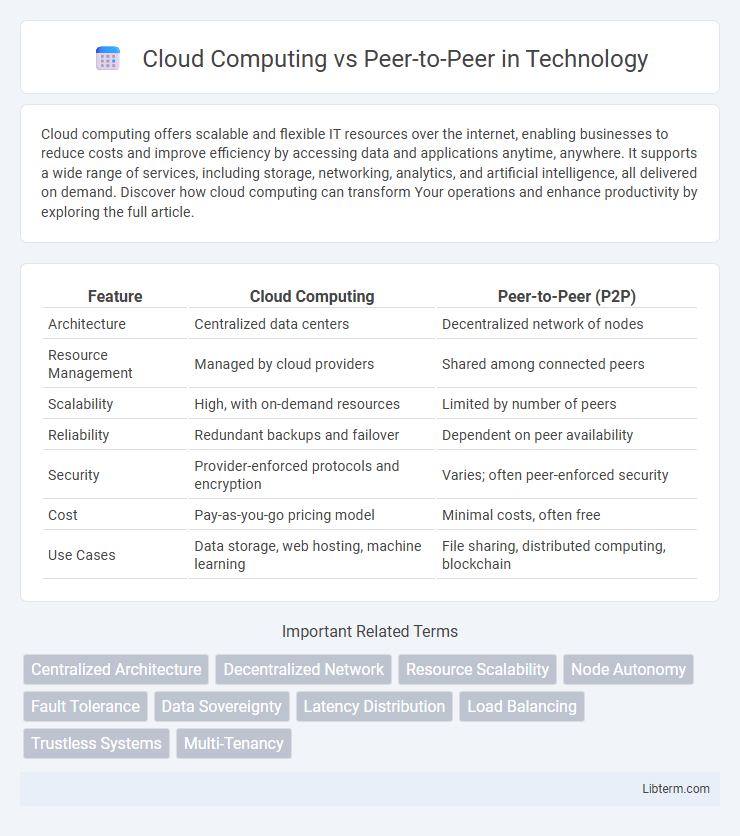Cloud computing offers scalable and flexible IT resources over the internet, enabling businesses to reduce costs and improve efficiency by accessing data and applications anytime, anywhere. It supports a wide range of services, including storage, networking, analytics, and artificial intelligence, all delivered on demand. Discover how cloud computing can transform Your operations and enhance productivity by exploring the full article.
Table of Comparison
| Feature | Cloud Computing | Peer-to-Peer (P2P) |
|---|---|---|
| Architecture | Centralized data centers | Decentralized network of nodes |
| Resource Management | Managed by cloud providers | Shared among connected peers |
| Scalability | High, with on-demand resources | Limited by number of peers |
| Reliability | Redundant backups and failover | Dependent on peer availability |
| Security | Provider-enforced protocols and encryption | Varies; often peer-enforced security |
| Cost | Pay-as-you-go pricing model | Minimal costs, often free |
| Use Cases | Data storage, web hosting, machine learning | File sharing, distributed computing, blockchain |
Introduction to Cloud Computing and Peer-to-Peer
Cloud computing enables on-demand access to scalable computing resources via the internet, utilizing centralized data centers for storage, processing, and software services. Peer-to-peer (P2P) networks distribute resources and tasks across interconnected devices without relying on centralized servers, allowing direct data sharing and communication between nodes. Both architectures support digital collaboration but differ significantly in control, scalability, and resource allocation models.
Core Concepts: Cloud Computing Explained
Cloud computing centralizes data storage, processing, and management on remote servers accessed via the internet, enabling scalable resource allocation and on-demand services. It relies on virtualization, distributed computing, and data centers to deliver Infrastructure as a Service (IaaS), Platform as a Service (PaaS), and Software as a Service (SaaS). Unlike peer-to-peer networks that distribute workloads across connected nodes, cloud computing offers centralized control, enhanced security, and consistent performance through managed service providers.
Fundamentals of Peer-to-Peer Networks
Peer-to-peer (P2P) networks operate on a decentralized model where each node simultaneously functions as both client and server, enabling direct resource sharing without centralized control. Cloud computing relies on centralized data centers managed by providers to deliver scalable computing resources and services over the internet. The fundamental advantage of P2P networks lies in their resilience, scalability, and reduced reliance on a single point of failure, contrasting with cloud computing's structured, provider-dependent architecture.
Architecture Comparison: Centralized vs Decentralized
Cloud computing architecture is centralized, relying on powerful data centers to provide scalable, on-demand services through a client-server model. Peer-to-peer (P2P) architecture is decentralized, distributing workloads across multiple nodes that share resources directly, enhancing fault tolerance and reducing single points of failure. Centralized cloud systems optimize resource management and maintenance, whereas P2P networks emphasize resilience and direct node-to-node communication.
Performance and Scalability Considerations
Cloud computing offers superior scalability through elastic resource allocation and centralized management, enabling high performance under variable workloads with minimal latency. Peer-to-peer networks distribute processing power among nodes, often resulting in unpredictable performance and limited scalability due to dependency on individual peer capacity and network conditions. For mission-critical applications requiring consistent throughput and rapid scaling, cloud computing generally outperforms peer-to-peer architectures in both speed and reliability.
Security and Privacy Challenges
Cloud computing often faces security challenges such as data breaches, unauthorized access, and compliance with regulatory standards due to centralized data storage. Peer-to-peer (P2P) networks, while decentralized, encounter privacy risks including exposure to malicious nodes, difficulty in enforcing data control, and vulnerability to distributed denial-of-service (DDoS) attacks. Ensuring robust encryption, authentication protocols, and continuous monitoring is crucial for mitigating security and privacy issues in both cloud and P2P environments.
Cost Efficiency and Resource Utilization
Cloud computing offers scalable resource utilization and cost efficiency through pay-as-you-go models, minimizing upfront infrastructure expenses and optimizing load distribution across centralized data centers. Peer-to-peer networks distribute workloads across multiple nodes, leveraging underutilized resources without relying on expensive centralized servers, resulting in reduced hardware costs and improved fault tolerance. Both models enhance resource utilization differently: cloud computing excels in dynamic scaling and managed services, while peer-to-peer focuses on decentralized efficiency and direct sharing among participants.
Use Cases: When to Choose Cloud or Peer-to-Peer
Cloud computing excels in scenarios requiring scalable resources, centralized management, and robust data backup, making it ideal for businesses with fluctuating workloads or global access needs. Peer-to-peer networks suit decentralized applications such as file sharing, collaborative platforms, or blockchain systems where equal participation and direct data exchange enhance efficiency and resilience. Selecting cloud or peer-to-peer depends on factors like control preferences, data sensitivity, scalability demands, and network reliability requirements.
Future Trends in Distributed Computing
Cloud computing continues to evolve with advancements in edge computing, serverless architectures, and AI integration, enhancing scalability and real-time data processing capabilities. Peer-to-peer networks are gaining traction through blockchain technologies and decentralized applications, promoting increased security, resilience, and user control over data. Future trends in distributed computing emphasize hybrid models combining cloud and peer-to-peer strengths to achieve greater efficiency, privacy, and cost-effectiveness.
Conclusion: Choosing the Right Approach
Selecting the appropriate technology depends on the specific needs of scalability, control, and resource distribution; cloud computing excels in centralized data management and elastic resource allocation, while peer-to-peer networks provide decentralized control and enhanced fault tolerance. Businesses prioritizing security, compliance, and predictable performance often favor cloud services, whereas applications requiring direct node-to-node communication and resilience benefit from peer-to-peer architectures. Evaluating workload characteristics, budget constraints, and desired infrastructure flexibility is essential for making an informed decision between cloud computing and peer-to-peer solutions.
Cloud Computing Infographic

 libterm.com
libterm.com